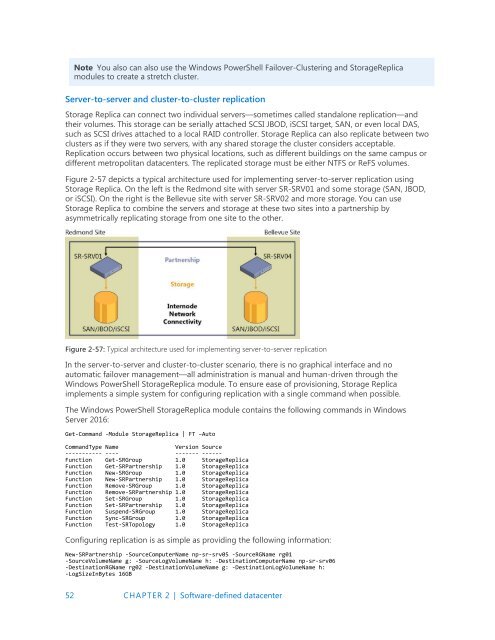Introducing
IntroducingWindowsServer2016_ebook
IntroducingWindowsServer2016_ebook
Create successful ePaper yourself
Turn your PDF publications into a flip-book with our unique Google optimized e-Paper software.
Note You also can also use the Windows PowerShell Failover-Clustering and StorageReplica<br />
modules to create a stretch cluster.<br />
Server-to-server and cluster-to-cluster replication<br />
Storage Replica can connect two individual servers—sometimes called standalone replication—and<br />
their volumes. This storage can be serially attached SCSI JBOD, iSCSI target, SAN, or even local DAS,<br />
such as SCSI drives attached to a local RAID controller. Storage Replica can also replicate between two<br />
clusters as if they were two servers, with any shared storage the cluster considers acceptable.<br />
Replication occurs between two physical locations, such as different buildings on the same campus or<br />
different metropolitan datacenters. The replicated storage must be either NTFS or ReFS volumes.<br />
Figure 2-57 depicts a typical architecture used for implementing server-to-server replication using<br />
Storage Replica. On the left is the Redmond site with server SR-SRV01 and some storage (SAN, JBOD,<br />
or iSCSI). On the right is the Bellevue site with server SR-SRV02 and more storage. You can use<br />
Storage Replica to combine the servers and storage at these two sites into a partnership by<br />
asymmetrically replicating storage from one site to the other.<br />
Figure 2-57: Typical architecture used for implementing server-to-server replication<br />
In the server-to-server and cluster-to-cluster scenario, there is no graphical interface and no<br />
automatic failover management—all administration is manual and human-driven through the<br />
Windows PowerShell StorageReplica module. To ensure ease of provisioning, Storage Replica<br />
implements a simple system for configuring replication with a single command when possible.<br />
The Windows PowerShell StorageReplica module contains the following commands in Windows<br />
Server 2016:<br />
Get-Command -Module StorageReplica | FT –Auto<br />
CommandType Name<br />
Version Source<br />
----------- ---- ------- ------<br />
Function Get-SRGroup 1.0 StorageReplica<br />
Function Get-SRPartnership 1.0 StorageReplica<br />
Function New-SRGroup 1.0 StorageReplica<br />
Function New-SRPartnership 1.0 StorageReplica<br />
Function Remove-SRGroup 1.0 StorageReplica<br />
Function Remove-SRPartnership 1.0 StorageReplica<br />
Function Set-SRGroup 1.0 StorageReplica<br />
Function Set-SRPartnership 1.0 StorageReplica<br />
Function Suspend-SRGroup 1.0 StorageReplica<br />
Function Sync-SRGroup 1.0 StorageReplica<br />
Function Test-SRTopology 1.0 StorageReplica<br />
Configuring replication is as simple as providing the following information:<br />
New-SRPartnership -SourceComputerName np-sr-srv05 -SourceRGName rg01<br />
-SourceVolumeName g: -SourceLogVolumeName h: -DestinationComputerName np-sr-srv06<br />
-DestinationRGName rg02 -DestinationVolumeName g: -DestinationLogVolumeName h:<br />
-LogSizeInBytes 16GB<br />
52 CHAPTER 2 | Software-defined datacenter


